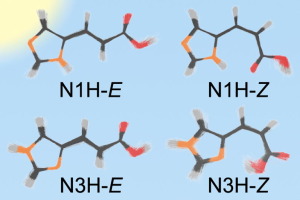Chemical Physics ( IF 2.0 ) Pub Date : 2018-09-25 , DOI: 10.1016/j.chemphys.2018.09.036 Deniz Tuna , Lasse Spörkel , Mario Barbatti , Walter Thiel

|
Urocanic acid (UA) is a UV filter found in human skin, which has been linked to photoimmunosuppression and the formation of skin cancer. Its UV-light-induced photoisomerization and radiationless deactivation mechanisms have been addressed previously by static calculations. In this paper, we present nonadiabatic trajectory-surface-hopping dynamics simulations of photoexcited UA using the semiempirical OM2/MRCI methodology and an adaptive-timestep algorithm. We have simulated almost 6000 trajectories, each for a simulation time of 1.6 ps, covering the entire conformational space of the E and Z isomers of both possible tautomers of the isolated neutral form of UA (overall 32 conformers). Initial conditions for the excited-state dynamics were obtained from 1 ns ground-state dynamics simulations. We find that UA has an ultrashort excited-state lifetime, which is due to ultrafast radiationless excited-state deactivation driven by EZ photoisomerization and excited-state intramolecular proton-transfer (ESIPT) processes. The computed S1 excited-state lifetimes for the E and Z isomers of the N1H and N3H tautomers range from 271 to 506 fs. The photoisomerization quantum yield is calculated to be 43% (32%) for the combined E (Z) isomers of both tautomers. The shorter lifetime and the lower photoisomerization quantum yield of the Z isomers can be rationalized by the larger number of available excited-state deactivation processes: the Z isomers can undergo ESIPT and photoisomerization, whereas the E isomers can only deactivate via the latter process. The intramolecular hydrogen bond that is present in many Z conformers can prevent successful photoisomerization to an E isomer. We find no evidence for an excitation-energy-dependent quantum yield for photoisomerization (EEDQY-PI) in isolated (E)-UA, which has previously been detected spectroscopically in aqueous solution. However, we do find an EEDQY-PI as well as a complementary excitation-energy-dependent quantum yield for ESIPT (EEDQY-ESIPT) for the N1H-Z isomers, which demonstrates the competition of the photoisomerization and ESIPT processes. The present comprehensive study lays the groundwork for future photodynamics simulations of UA in the aqueous phase.
中文翻译:

光激发的尿酸的非绝热动力学模拟
尿酸(UA)是一种在人体皮肤中发现的紫外线过滤剂,与光免疫抑制和皮肤癌的形成有关。它的紫外线诱导的光致异构化和无辐射失活机理先前已通过静态计算得到解决。在本文中,我们使用半经验的OM2 / MRCI方法和自适应时步算法介绍了光激发UA的非绝热轨迹表面跳动动力学模拟。我们已经模拟了近6000条轨迹,每条轨迹的仿真时间为1.6 ps,涵盖了E和Z的整个构象空间UA的中性形式的两种可能的互变异构体的异构体(总共32个构象异构体)。激发态动力学的初始条件是从1 ns的基态动力学模拟获得的。我们发现UA具有超短的激发态寿命,这是由于E驱动的超快的无辐射激发态失活Z光异构化和激发态分子内质子转移(ESIPT)过程。N1H和N3H互变异构体的E和Z异构体的计算出的S 1激发态寿命为271至506 fs。对于两种互变异构体的组合的E(Z)异构体,光异构化量子产率经计算为43%(32%)。Z异构体的较短寿命和较低的光异构化量子产率可以通过大量可用的激发态失活过程来合理化:Z异构体可以进行ESIPT和光异构化,而E异构体只能通过后一种过程失活。许多Z构象异构体中存在的分子内氢键可能会阻止成功的光异构化为E异构体。我们没有发现分离的(E)-UA中光异构化(EEDQY-PI)的激发能量依赖的量子产率的证据,该分离先前已在水溶液中通过光谱法检测到。但是,我们确实发现了N1H- Z异构体的EIPQY-PI以及ESIPT的互补激发能依赖的量子产率(EEDQY-ESIPT),这表明了光异构化和ESIPT过程的竞争。本综合研究为水相UA的未来光动力学模拟奠定了基础。











































 京公网安备 11010802027423号
京公网安备 11010802027423号